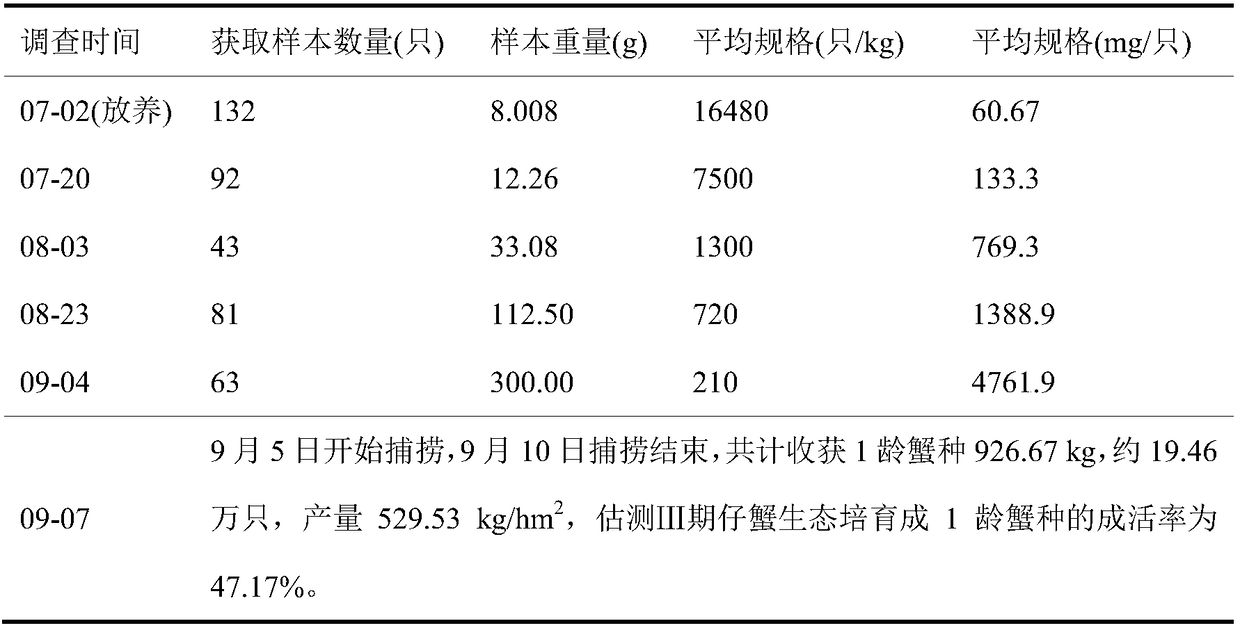Method for ecologically breeding III-stage juvenile crabs into1-age crab variety through salt marsh wetland
A technology for young crabs and wetlands, applied in fish farming, application, climate change adaptation, etc., can solve problems that have not been developed and utilized, and achieve the effect of increasing self-sufficiency
- Summary
- Abstract
- Description
- Claims
- Application Information
AI Technical Summary
Problems solved by technology
Method used
Image
Examples
specific Embodiment approach 1
[0032] Specific implementation mode one: a method for ecologically cultivating larval crabs of stage III in salt marsh wetlands into 1-year-old crab species according to the present embodiment is carried out through the following steps:
[0033] 1. Selection of cultivation pool:
[0034] ⅰ. Location: ①The terrain is relatively low-lying and easy to transform; ②The vegetation coverage exceeds 80%, and the biomass is 1.0kg / m 2 Above, there is no need to artificially plant aquatic plants; ③Underground fresh water resources are relatively abundant, or close to surface water diversion channels to ensure sufficient water sources; ii. Area: too large or too small area of the cultivation pool is not conducive to water quality control and management, and the value of 1.0~ 2.0hm 2 appropriate;
[0035] 2. Establish a fresh water source guarantee system:
[0036] The third-stage larvae and the first-year-old crab species are suitable for living in freshwater environments, but the sa...
specific Embodiment approach 2
[0045] Specific implementation mode 2: The difference between this implementation mode and specific implementation mode 1 is that the establishment of a fresh water source guarantee system in step 2 is to drill a motor-driven well to extract underground fresh water, and at the same time build surface water diversion channels to utilize surface fresh water. The two complement each other . Other steps and parameters are the same as those in the first embodiment.
specific Embodiment approach 3
[0046]Specific embodiment three: the difference between this embodiment and specific embodiment one or two is that the slope-shaped ring ditch in step three is a ring-shaped ditch with a width of 8-10m excavated around and inclined 8°-10° to the surroundings. Embankment, so that the water depth at the lowest part of the ring ditch reaches 1.2-1.5m. Other steps and parameters are the same as those in Embodiment 1 or 2.
PUM
 Login to View More
Login to View More Abstract
Description
Claims
Application Information
 Login to View More
Login to View More - R&D
- Intellectual Property
- Life Sciences
- Materials
- Tech Scout
- Unparalleled Data Quality
- Higher Quality Content
- 60% Fewer Hallucinations
Browse by: Latest US Patents, China's latest patents, Technical Efficacy Thesaurus, Application Domain, Technology Topic, Popular Technical Reports.
© 2025 PatSnap. All rights reserved.Legal|Privacy policy|Modern Slavery Act Transparency Statement|Sitemap|About US| Contact US: help@patsnap.com

